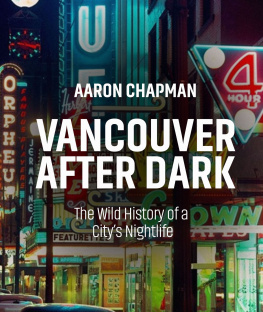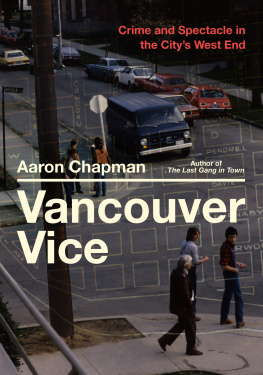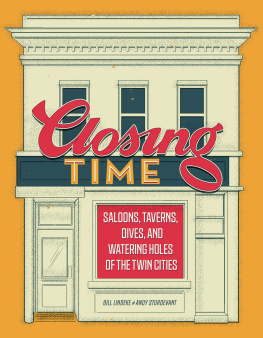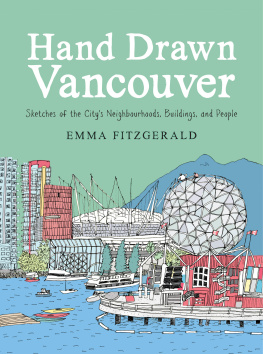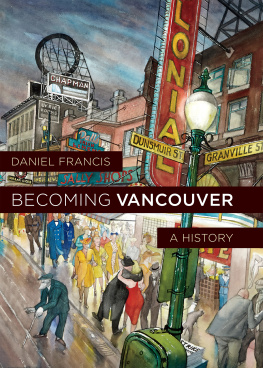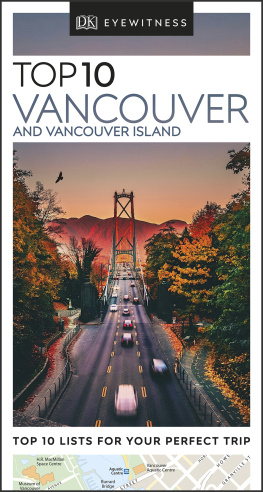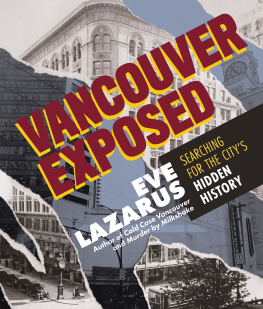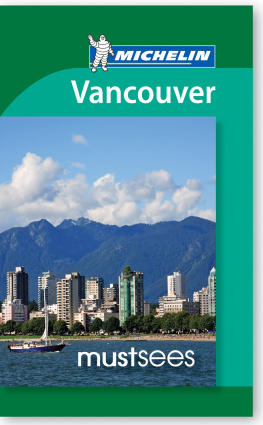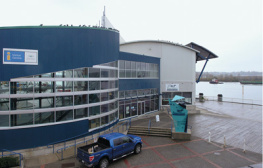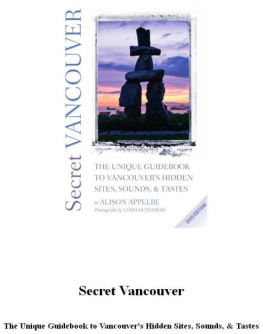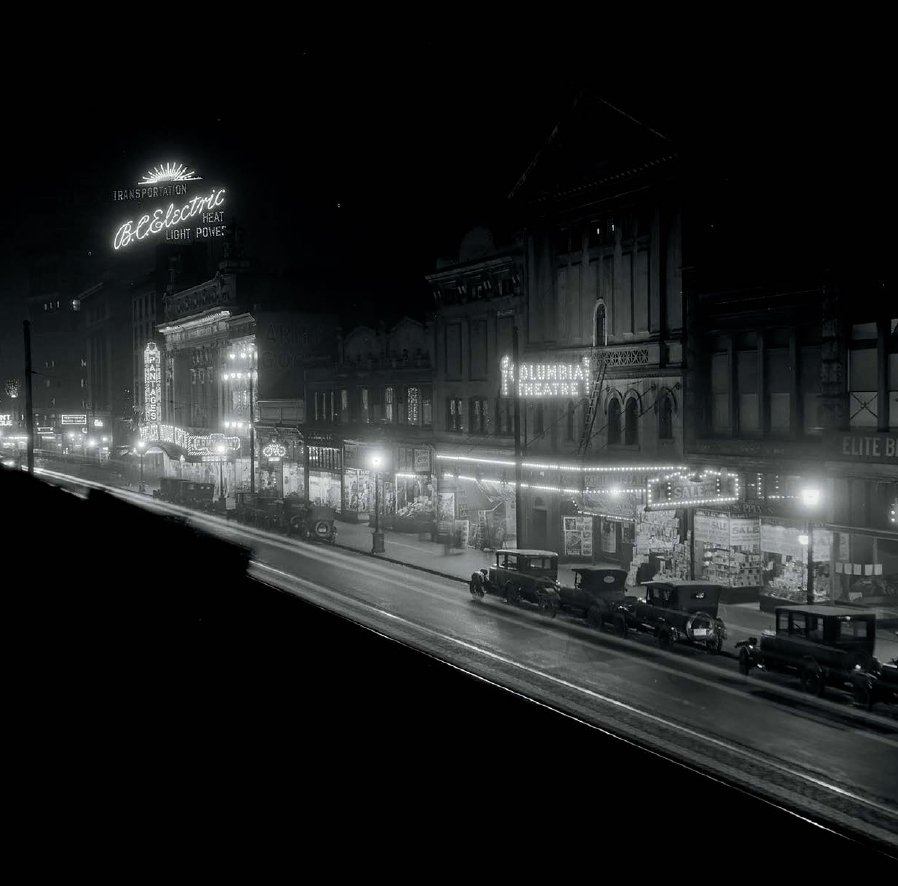
VANCOUVER AFTER DARK
VANCOUVER AFTER DARK
The Wild History of a Citys Nightlife
AARON CHAPMAN

VANCOUVER AFTER DARK
Copyright 2019 by Aaron Chapman
Published in the United States of America in 2020
SECOND PRINTING: 2020
All rights reserved. No part of this book may be reproduced in any part by any meansgraphic, electronic, or mechanicalwithout the prior written permission of the publisher, except by a reviewer, who may use brief excerpts in a review, or in the case of photocopying in Canada, a licence from Access Copyright.
ARSENAL PULP PRESS
Suite 202 211 East Georgia St.
Vancouver, BC V6A 1Z6
Canada
arsenalpulp.com
The publisher gratefully acknowledges the support of the Canada Council for the Arts and the British Columbia Arts Council for its publishing program, and the Government of Canada, and the Government of British Columbia (through the Book Publishing Tax Credit Program), for its publishing activities.
Arsenal Pulp Press acknowledges the xmkym (Musqueam), Swxw7mesh (Squamish), and slilwta (Tsleil-Waututh) Nations, speakers of Hulquminum/Halqemylem/ hnqminm and custodians of the traditional, ancestral, and unceded territories where our office is located. We pay respect to their histories, traditions, and continuous living cultures and commit to accountability, respectful relations, and friendship.
Cover design by Oliver McPartlin
Text design by Electra Design Group
Front cover photo: Granville Street, 1959. Ken Oakes, Vancouver Sun
Edited by Derek Fairbridge
Copy edited by Shirarose Wilensky
Proofread by Alison Strobel
Printed and bound in Canada
Library and Archives Canada Cataloguing Publication:
Title: Vancouver after dark : the wild history of a citys nightlife / Aaron Chapman
Names: Chapman, Aaron, 1971 author.
Identifiers: Canadiana 20190130156 | ISBN 9781551527833 (softcover)
Subjects: LCSH: Popular musicBritish ColumbiaVancouverHistory and criticism. LCSH: NightclubsBritish ColumbiaVancouverHistory.
Classification: LCC ML3484.8 V22 C46 2019 | LCC ML3484.8* | DDC 782.421640971133dc23
CONTENTS
West Hastings Street at night in the 1920s. Credit: Dominion Photo company c/o the VPL Special Collections #22253
INTRODUCTION
Im on the guest list. Whats the cover charge? Good to see you again! I thought I told you you werent allowed in here anymore? What time do you open? What time is the band on? What time do you close? Can you work for me tonight? Is it last call? Can I get your number? What are you doing now? What are you doing later? Can your friend come along? Can your friend stay home? Can we leave the gear here overnight? What do you mean you gave the money to the drummer? What was the name of that place again? Ill never forget that night
The nocturnal language found in nightclubs is perhaps the same the world over. But if you check out any travel guide, tourist brochure, or promotional film about Vancouver over the decades, youll notice they rarely showcase the citys nightlife. Aside from a few nondescript photos of twinkling city lights at nightshown to reassure visitors that nighttime does indeed exist hereVancouver after dark is not usually presented to visitors as the main attraction.
Instead, Vancouver tends to value its picturesque daytime beauty above all else. The imagery of the city that is sold to the outside world depicts bright bustling neighbourhoods full of boutique shops, set against a backdrop of photogenic beaches and mountains, both of which can be visited in the same afternoon. When they are shown at all, images of the citys nightlife delve no deeper than a few suggestions of smiling couples dining at a nameless bistro or a group of friends cheering in an arena for a sports eventalmost as if to caution those who do step out for the night not to stray too far or stay out too late. Dont sleep in, dont miss getting up early to sip a designer coffee on some waterfront patio with an Instagram-worthy view. But there is more to Vancouver than sunny English Bay beaches or sophisticated Yaletown gastropubs that is worthy of being celebrated.
Perhaps its not surprising that Vancouvers nightlife has never been honoured as much as its daytime equivalent, because those who ran the city over the decades have done their best to suppress its nocturnal side, monitoring not only the kinds of nightspots its citizens might escape to but also what they did there. There were cafs that were allowed to serve food but not offer entertainment. There were cabarets that presented musical acts, but patrons were not allowed to get up and dance. And there were supper clubs that both offered entertainment and served food but could not sell alcohol. Perhaps no single industry in the history of Vancouver has been as regulated and constricted over the years as its nightclubs. In the 1950s and 60s, the Vancouver Police Department (VPD) spent their time conducting dry squad raids to ensure nightclub patrons were not imbibing alcohol. Pious government officials viewed alcohol consumption with suspicion and regarded those who frequented nightclubs with disdain. God forbid an evenings entertainment involve seeing a show, having a dance, and enjoying a drink or two. The fear about alcoholthe blood that ran through the nightclubs veinswas that it would reduce good upstanding citizens to desperate vampires who would surely forget their daytime responsibilities to their families, their country, and their faith if booze were ever freely available to them at night.

Granville Street, 1966. Credit: Aaron Chapman Archives
But despite all the citys efforts to make the lives of both those who managed and went to nightclubs difficult, the ballrooms, the lounges, the dives, and the discos have always been here, even if those places havent always boldly advertised themselves.
Vancouver is overdue to proudly showcase the history of the unique nightlife that developed here. The city benefitted from being on Canadas western frontier. In the 1950s and 60s, many visiting American entertainers, following established touring routes that went back to the days of vaudeville, came north to Vancouver to perform, and then simply turned around and headed back down the Pacific coast once their engagements finished, instead of continuing eastward through the rest of Canada. Vancouver got to see performers that the rest of the country often missed out on.
In the 1970s, when original music by Vancouverbased artists took on greater prominence, some of Canadas most defiant rock n roll poured out of the citys nightclubs. Vancouvers nightclub owners prospered humbly, often in downbeat locations, where they fostered world-class musicians who could compete with any New York or Hollywood session player. And one of those most downtrodden skid row clubs incubated the biggest comedy duo of the decade. In the 1980s, a litany of some of the biggest rock bands began to camp out in one of the citys legendary recording studios and were seen regularly blowing off steam at downtown nightclubs. In the 1990s, as modern DJs emerged in the local underground dance clubs, their playlists got noticed globally. What is it about the rainy mists of Vancouver that has inspired such world-renowned musicians, singers, DJs, and club impresarios over the decades?
Next page
